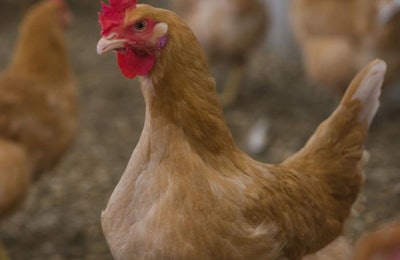
Bell & Evans, a family owned company in Fredericksburg, Pennsylvania, is currently transitioning to what it refers to as a higher-welfare, slower-growing, more flavorful breed of broiler chickens.
The new breed, Das Klassenbester, will completely replace Bell & Evans’ current breed of chickens by the end of 2018. Bell & Evans will be the first U.S. chicken producer to fully convert to a higher-welfare, slower-growing, more flavorful chicken breed, the company says.
“We expect to invest more than $75 million in the new breed during the first five years, an investment I can’t see commodity producers making,” said Bell & Evans Owner Scott Sechler. “We don’t raise commodity chickens. Every single chicken we process passes through our organic-certified hatchery, never receives an antibiotic – even while in the egg – and have the same genetics, taking away all guesswork for our customers. We’re pretty proud to say that 100 percent of our products will come from a higher-welfare, better-quality breed.”
About the Das Klassenbester breed
For decades, small and large chicken producers alike have had the same access to limited breed options as offered by a small number of breeding companies.
In 2015, Sechler pursued options for a better-quality breed of chickens by working with European breeders. A specialty female breed was selected for its slow growth and high meat yield, and a male breed was chosen for its excellent meat yield, fertility and livability rates. The new breed of offspring was named “Das Klassenbester” for its European descent and premium, best-in-class genetics.
“This is a big deal,” said Sechler. “So far, our testing has netted healthy, hardy chickens that result in a great-tasting, high-quality product with lots of flavor. No white striping or woody breasts were detected. We’re really excited to fully convert to the Klassenbester.”
The new breeds look different, too. The females have rich reddish-brown feathers while the males are slightly larger than the females and have bright white feathers. The Klassenbester broilers are mostly white feathered with some sporadic color variations.
The first female pullets were placed into Bell & Evans’ pullet houses in May 2017. By the end of 2018, 100 percent of Bell & Evans’ chickens will be fully converted to the new breed. Bell & Evans already grows its chickens to a smaller size than most producers, averaging a live weight of only 5.6 pounds over 41 days. The new breed will average the same live weight, but will grow slower over 47 to 50 days, extending the growth cycle upwards of 15 percent and reducing unnecessary stress on their bodies, resulting in better overall health, according to Bell & Evans.
This investment in a higher-welfare, slower-growing breed will cost Bell & Evans an estimated $14 million in additional feed per year. The females were also purchased at a premium. The company considers the new breed an addition to its Bell & Evans Humane Animal Welfare Standard.
















